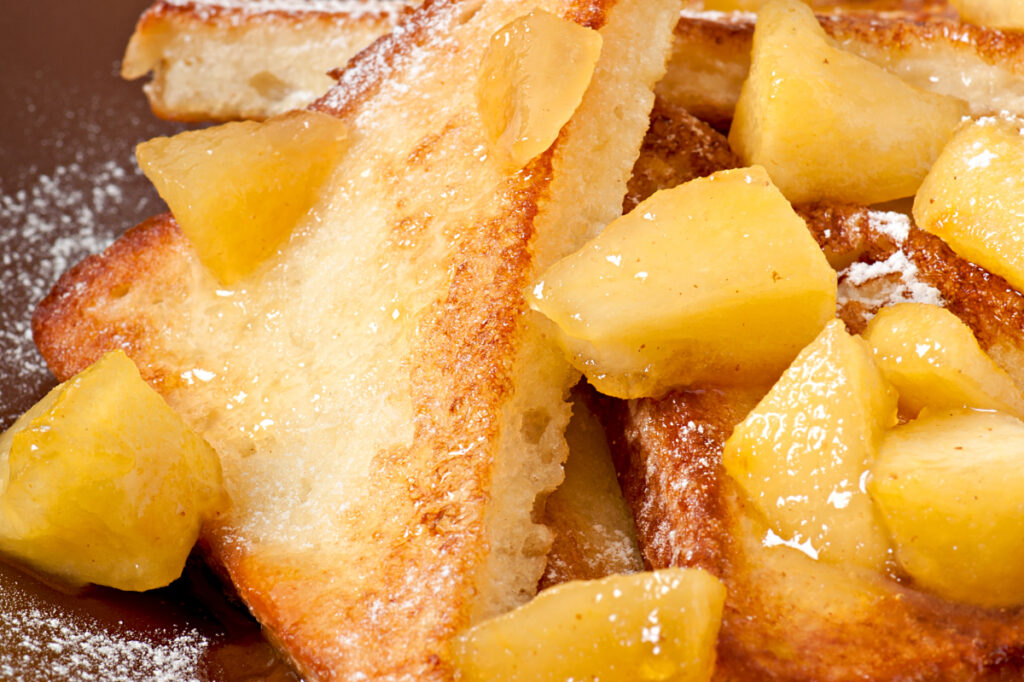French toast is a staple breakfast dish that’s loved for its crispy edges, custardy interior, and rich flavor. However, achieving that perfect texture can be challenging, especially when your French toast turns out gooey or soggy. The good news is that by following a few essential tips, you can avoid these common pitfalls and make restaurant-quality French toast at home.
For creative ways to improve your baking, check out Use Bananas Instead of Butter in Baking for tips on enhancing your recipes with healthier alternatives.

This guide will help you identify what causes gooey French toast, choose the right ingredients, and master cooking techniques for the perfect breakfast dish.
Why Does French Toast Turn Gooey?
There are several reasons French toast can become gooey or soggy:
- Over-soaking the bread: Bread that absorbs too much custard becomes mushy inside.
- Using thin bread slices: Thin bread lacks the structure to hold the custard, leading to sogginess.
- Cooking at the wrong temperature: High heat burns the outside while leaving the inside undercooked.
Understanding these causes is the first step in troubleshooting and improving your French toast.
Choosing the Right Ingredients
The Best Bread for French Toast
The foundation of great French toast lies in the bread you choose. Here are the best options:
- Brioche: This rich, buttery bread absorbs custard without falling apart.
- Challah: Slightly sweet and firm, challah retains its shape during cooking.
- Texas Toast: Thick and pre-sliced, this bread is perfect for beginners.
- Sourdough: Adds a slight tang and is sturdy enough for soaking.
Avoid soft sandwich bread, as it soaks up too much liquid and becomes mushy. If you’re interested in experimenting with textures, try the tips in Substitute for Butter in Banana Bread to adjust the base of your recipe.
The Perfect Custard Mixture
A well-balanced custard is crucial for avoiding gooey French toast. Use these tips:
- Eggs: Use 2–3 eggs for every cup of milk.
- Heavy cream or whole milk: These create a creamy texture without making the mixture too watery.
- Flavorings: Enhance your custard with vanilla extract, ground cinnamon, nutmeg, or almond extract.
- Sweeteners: A tablespoon of sugar or honey adds sweetness to the custard.
A properly prepared custard ensures that the bread is flavorful and cooked evenly.
Techniques for Perfect French Toast
Soaking the Bread
The soaking process determines whether your French toast will be perfect or soggy. Follow these steps:
- Dip each slice in the custard for 10–20 seconds. Avoid letting the bread sit in the mixture for too long.
- Let excess custard drip off. Place the soaked bread on a wire rack to remove excess liquid.
- Don’t stack slices. Allow air circulation around each piece to maintain their structure.
Cooking French Toast Evenly
Cooking French toast at the right temperature ensures a golden crust and a soft interior:
- Medium-low heat: Prevents burning while allowing the custard to cook through.
- Butter and oil combination: Use butter for flavor and oil to prevent the butter from burning.
- Flip gently: Turn the bread with care to avoid breaking it.
For evenly cooked French toast, consider techniques similar to those in Cinnamon Sugar Muffins, where controlled cooking delivers consistent results.
Avoiding Common Mistakes
Even experienced cooks can make mistakes when preparing French toast. Here’s how to avoid common pitfalls:
- Over-soaking: Too much time in the custard leads to soggy bread.
- Using thin bread: Thin slices cannot hold up during cooking.
- Cooking on high heat: High temperatures burn the exterior while leaving the inside undercooked.
Correcting these errors ensures a professional-quality dish every time.
Enhancing Flavor and Texture
Creative Additions to the Custard
Enhance your French toast batter with creative flavorings:
- Spices: Add cinnamon, nutmeg, or cardamom for warmth.
- Zests: Lemon or orange zest adds brightness.
- Extracts: Almond or maple extract enhances the custard’s flavor profile.
Toppings for the Perfect Finish
Once your French toast is cooked, elevate it with delicious toppings:
- Powdered sugar: A classic dusting for a sweet finish.
- Fresh fruit: Add natural sweetness with berries, bananas, or sliced apples.
- Whipped cream: For an indulgent breakfast treat.
- Caramelized sugar: Sprinkle granulated sugar on the bread before flipping for a crispy, caramelized crust.
For more inspiration on adding the perfect finishing touch, explore recipes like Banana Bread Recipe Without Butter for innovative flavor combinations.
Advanced Tips for Better French Toast
Dry Out the Bread
Stale or slightly dried bread soaks up custard more evenly without becoming soggy. Let fresh bread sit out for a few hours, or lightly toast it before soaking.
Experiment With Flavors
Turn traditional French toast into a gourmet dish with these ideas:
- Savory French toast: Skip the sugar and serve with cheese, herbs, or avocado.
- Stuffed French toast: Add cream cheese, jam, or Nutella between slices for a decadent twist.
- Vegan French toast: Substitute eggs with a mixture of almond milk, cornstarch, and vanilla extract.
FAQs About Avoiding Gooey French Toast
What Kind of Bread Is Best for French Toast?
Thick slices of brioche, challah, or Texas toast are ideal. Their sturdy structure prevents sogginess while soaking up custard.
How Long Should You Soak French Toast?
Each slice should soak for about 10–20 seconds. Avoid leaving the bread in the custard for too long, as it will absorb excess liquid.
What’s the Best Way to Avoid Burnt Edges?
Cook on medium-low heat, using a mix of butter and oil. This combination ensures even cooking and prevents burning.
Can You Make French Toast Ahead of Time?
Yes! Cooked French toast can be stored in the fridge for up to three days or frozen for longer storage. Reheat in the oven or toaster for a crispy texture.
What Should I Do With Leftover Custard?
Leftover custard can be used to make scrambled eggs, bread pudding, or additional French toast.
Final Thoughts on Perfect French Toast
Making French toast that’s crispy on the outside and soft on the inside requires careful attention to ingredients, soaking time, and cooking techniques. By using thick bread, crafting a balanced custard, and cooking at the right temperature, you can elevate your French toast to bakery-quality.
Looking for more baking inspiration? Check out Cinnamon Sugar Muffins for tips on creating delicious breakfast treats, or explore Substitute for Butter in Banana Bread for healthier recipe alternatives.
